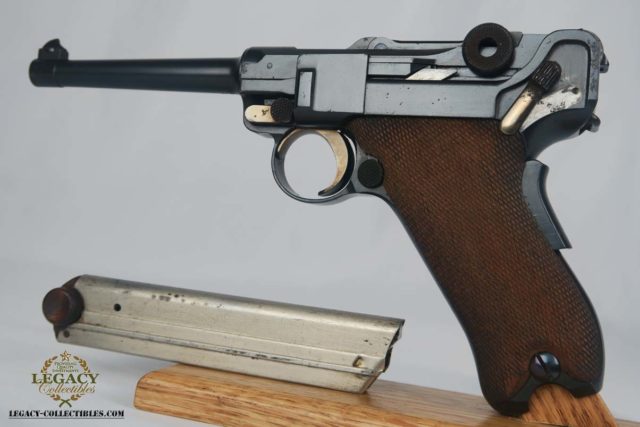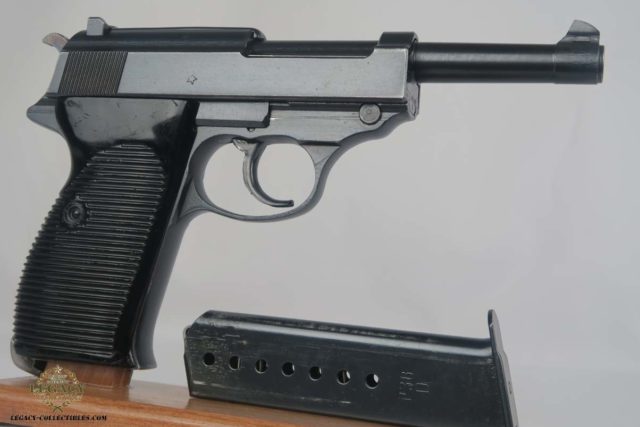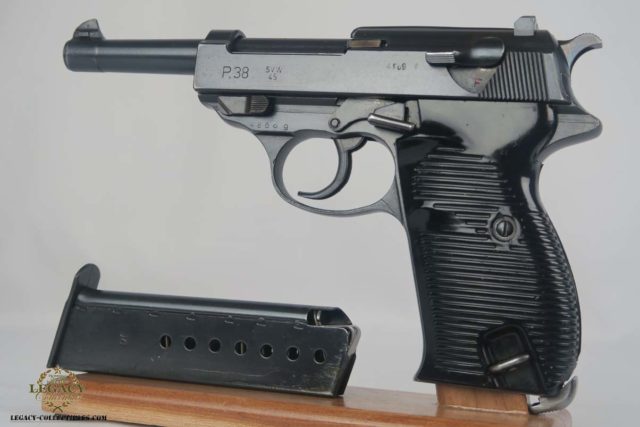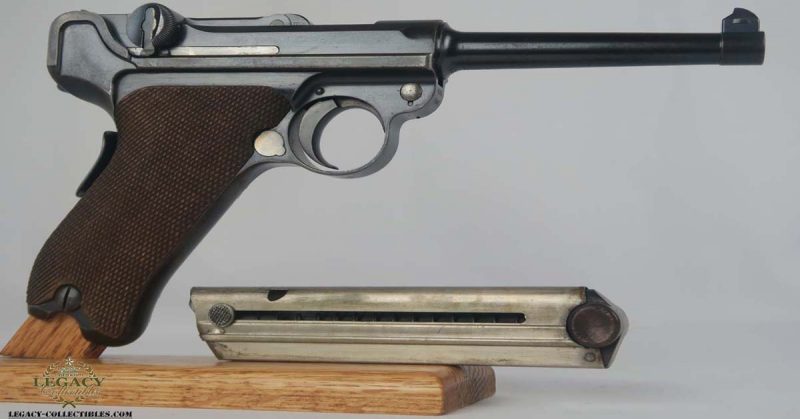War History Online presents this Guest Article by Tom Whiteman, long-time Luger and Walther collector and owner of Legacy Collectibles.
Effective Military Weapons
The Luger and Walther P.38 handguns were proven effective military weapons in their time. While production of the Luger started in the 1870’s, updated versions and military advances eventually led to its demise in the late 1930’s to early 40’s. The P.38 superseded the Luger once production halted in 1942, and it became the German military’s go-to choice for weaponry.
Beginning of Luger
The Luger has a rich history and diverse background. Georg Luger, who is the namesake for the commonly called “Luger pistol,” worked with Ludwig Loewe of Berlin during these early years of design and production. While traveling to the United States to illustrate a rifle, Georg Luger met Hugo Borchardt. Around 1894, approximately three years after meeting Luger, Borchardt accepted a position in partnership with Luger and Loewe. This trio led to the creation of Deutsche Waffen and Munitionsfabriken (DWM) company of Berlin-Karlsruhe. Guns were manufactured in Berlin, while ammunition was produced in the Karlsruhe facility.

While the Borchardt pistol was made of high-quality metals and exceptional craftsmanship, it was bulky and awkward to operate. Georg Luger took on the task of redesigning the weapon to meet the specifications requested by potential customers. Some of these changes included altering the trigger, inclining the grip, shortening the barrel, and repositioning the breechblock. The adjustments made to the gun proved satisfactory when used in a pistol trial in Bern, Switzerland, where it outperformed every gun it went up against. This early version of the Luger is referred to as the Model 1900. It is considered a transitional piece as it was only made for a year or two.
The transition piece known as Model 1900 was an instant success. Thousands of orders were placed from the Swiss, Americans, and other International retailers. Continual improvements to the 1900 were made, and by 1902 the 9mm Luger cartridge was developed. This is still the most used and most popular cartridge in the world.
During this period there were even US Military Test Lugers sent to the United States to be used in trials for acceptance by the US Army. While a very popular variation, it is fortunate that the US Army instead went with the 1911 Colt. They were about to go to war with Germany and would have certainly regretted a decision to accept the German Luger as the standard sidearm of the US Army.
Adoption of the Luger to the German Army
By 1908 the German Army adopted the Luger as its official sidearm. This was a total game changer for the Luger Pistol and the fortunes of the DWM factory. With the start of World War I in 1914, the German military ordered the model 1908/14 Luger by the hundreds of thousands.
Another big development for the influence of the Luger upon history came after World War I following the Treaty of Versailles. The Treaty declared that German manufacturers could not make calibers larger than 8mm and barrels could not exceed 100mm. Fortunately for the Luger developers, they designed the pistol so that the barrel could be easily changed; thus saving a lot of time and money getting their products back on the International markets.
Between the 1920’s and the 1930’s, the DWM factory transformed their offerings by creating multiple sizes and models. The entire world was experiencing the Great Depression and few countries suffered more than Germany. DWM was able to stay solvent by selling creative models on the worldwide market. One rendition included a Baby Luger model, similar to the Japanese Baby Nambu. Only about a dozen of the Baby Lugers are known to exist and they continue to be highly sought after by Luger collectors.
In 1930 Deutsche Waffen and Munitionsfabriken (DWM) company became a member of the holding company that controlled Mauser-Werke. Mauser became the new manufacturing supplier of the Lugers ramping up their first Luger models by 1934. In that year they made the “K Date” variation with only about 10,000 made. However, with the rise of Hitler and Nazism in 1933, everything was about to change. The goal of making popular variations for the world markets was replaced with the primary goal of rebuilding the German Army.
Hitler facilitated the total disregard for Treaty of Versailles and once again, the Mauser factory started producing Lugers by the hundreds of thousands. Now the Luger DWM logo on the top of the Luger was replaced with a series of codes. This was done to confuse potential enemies as to where and how many new Lugers were being made. The progression of Mauser codes, went from K date, G date, S/42 code, 42 code, and finally BYF.
Other Production
Generally, DWM held a monopoly on Luger production during WW1. A few enterprising industrialists were able to produce licensed copies of the Luger in order to keep up with demand for the Luger especially during the war. These maintained relatively small production numbers. They included the Erfurt Luger and Simson Luger.
Once the war ended these two producers struggled to stay in business. Erfurt eventually ceased production. The Simson factory also ran into very difficult times, and as a sad note in German history, the factory assets were seized by the German government as the Nazi’s came to power. Simson was a Jewish family owned business. Ironically, Heinrich Krieghoff was either given or purchased these assets (family members dispute this history) from the German government. Krieghoff was a hunting buddy and social friend of Herman Goring. Goring, of course, was the head of the Luftwaffe (German Air Force). Subsequently, Krieghoff was given a Luger contract to make lugers for pilots and Luftwaffe troops including paratroopers. The Krieghoff factory made Lugers in very small numbers starting in 1936 and continued until the end of the war. They were the only manufacturer to continue production of the Luger beyond 1942.
The Decline of Luger
In 1900 the design of the Luger was revolutionary and buyers around the world embraced them for personal use, military, and for the police. However, decades later improved designs were coming to the forefront. The Luger, while effective, was known for jamming as it has a lot of moving parts. Also, it was expensive to produce and/or repair.
Another German gun maker, Carl Walther, was working on a new, simpler design for a 9mm pistol. As creator of the Walther PP and PPK pistols, he was already successful at getting police and military contracts, but these smaller, 32 caliber weapons did not meet specifications for the German Military. In 1938, Walther finalized his design for the P.38. After numerous trials, it was adopted for the German Armed Forces and contracts started being filled in 1940.
Production of the P.38
The Walther P.38 employed a much simpler design, with fewer moving parts and potential for quick field repair. The cost to produce the gun was about one-third less than the Luger. The design was so successful that is it is still used today.

The Walther factory made a little under 10,000 guns per month but once again could not keep up with the wartime demands. Mauser (seeing the way of the future) decided to end production of the Luger and adapt their machining to produce the Mauser P.38, under a licensing agreement with Walther. The last Mauser Lugers were made in mid-1942 and production of the P.38 began in the same year. A year later, a similar licensing agreement was made with Spreewerk. A total of 1.2 Million P.38’s were made for Germany in WW2 between 1939-1945.
Both the Luger and Walther P.38 were effective handguns and innovative in their time. While they were produced roughly 50 years apart, they were both staples of the German Army during WW2. They also paved the way, and are considered the precursor to many modern handguns. Both the Luger and the Walther are still highly sought after by collectors around the world for their rich and diverse history.

Author Bio:
Tom Whiteman bought his first Luger as a college student in Florida. This began a 40-year quest to collect the finest variations of both Lugers and Walther pistols. Today he owns Legacy Collectibles having turned his hobby into a thriving business.
